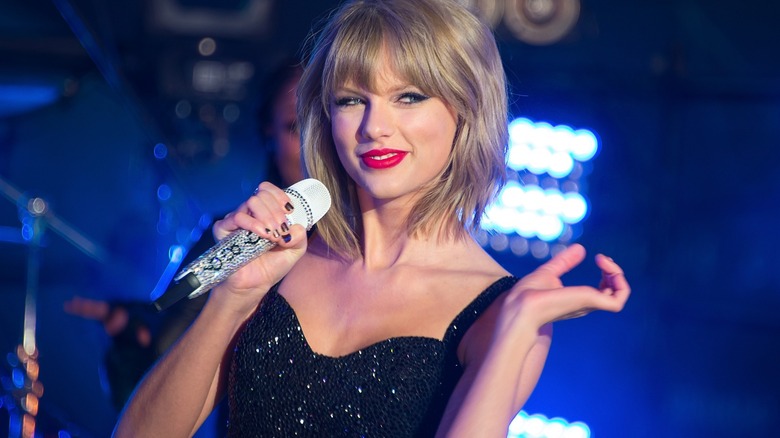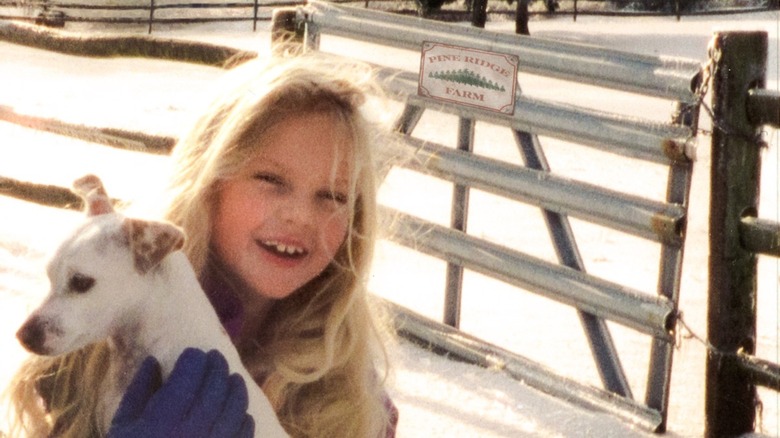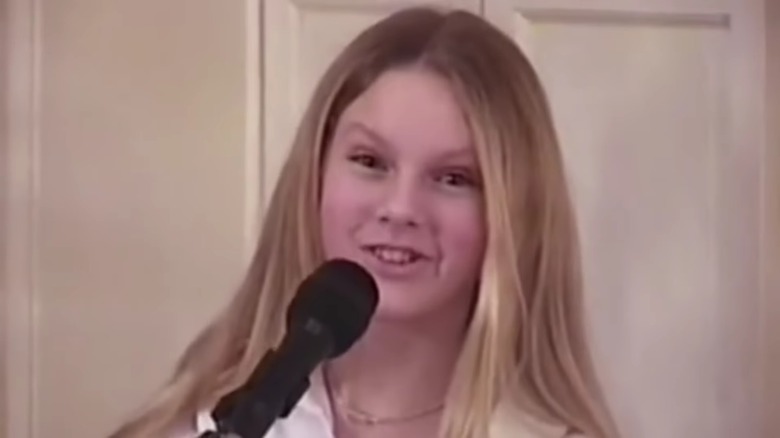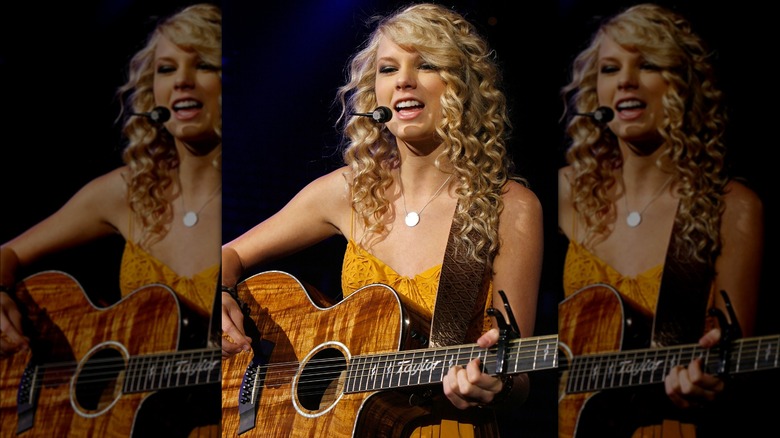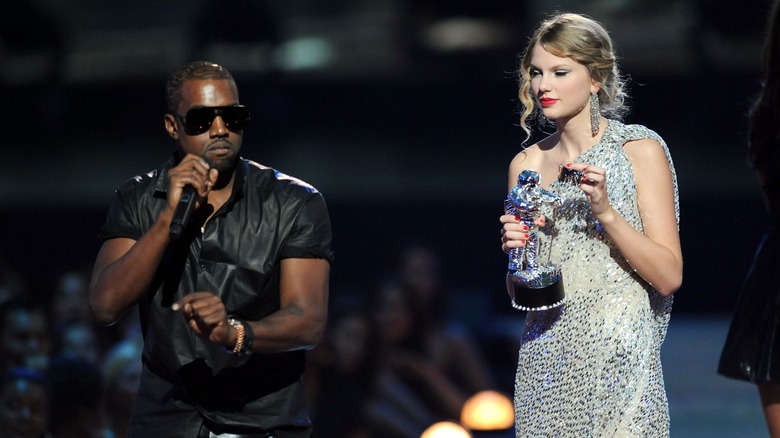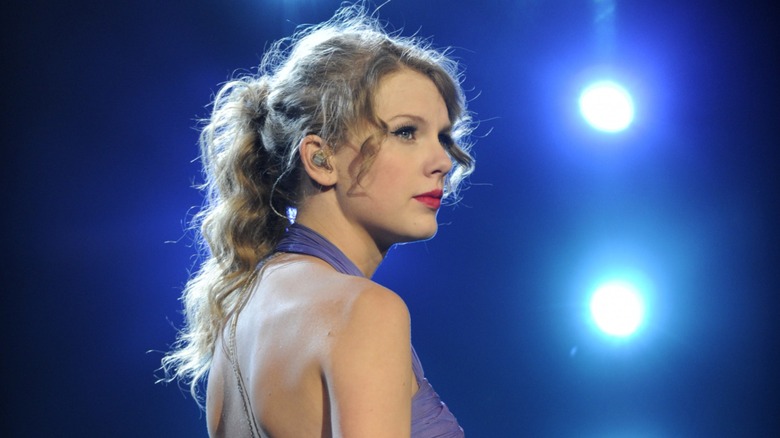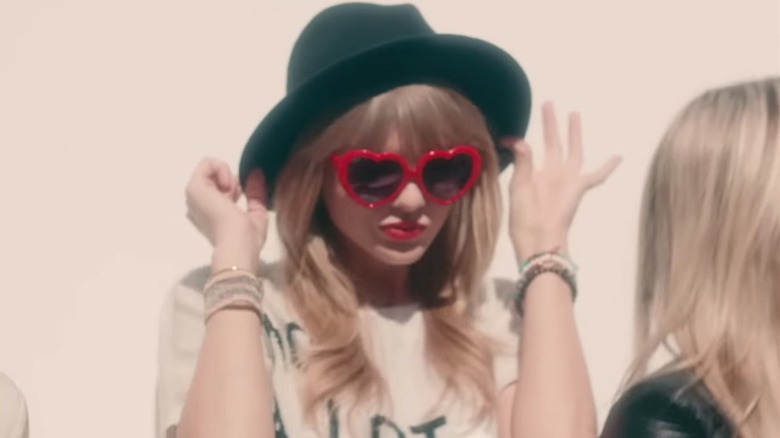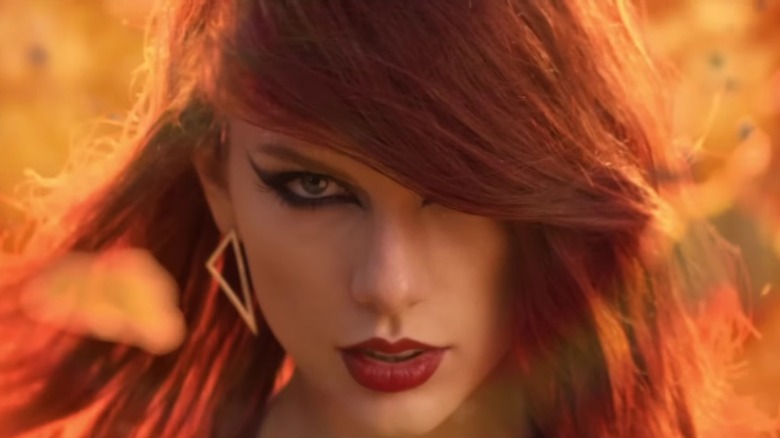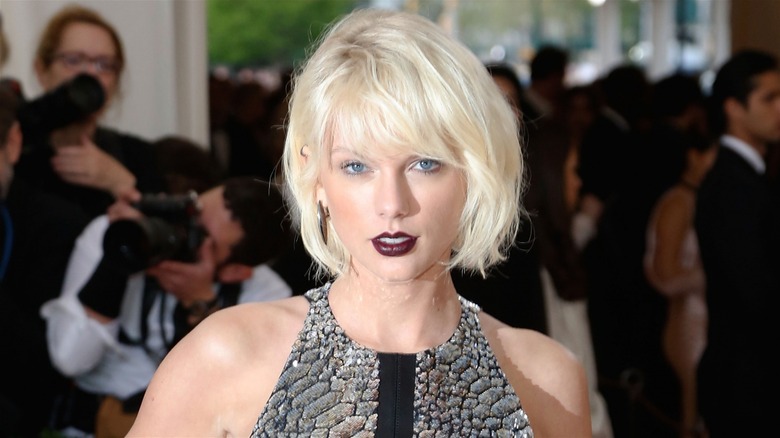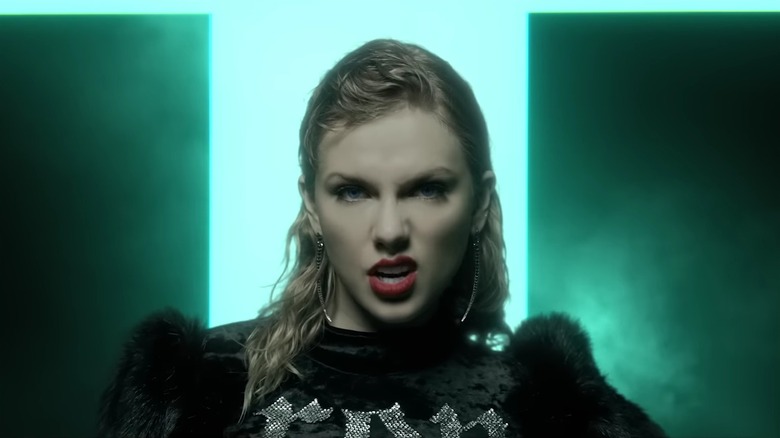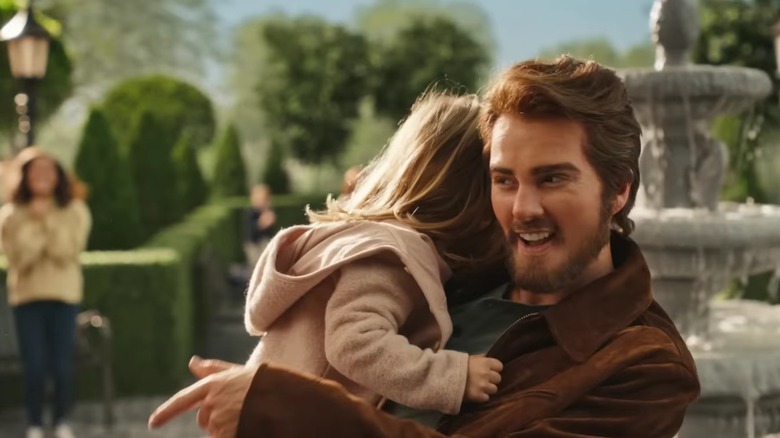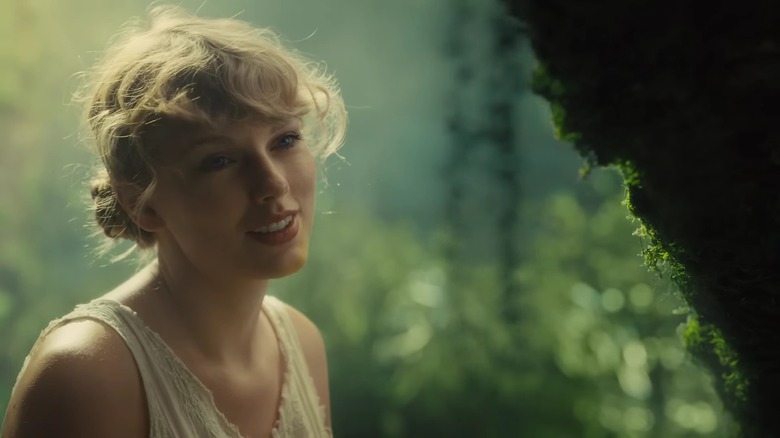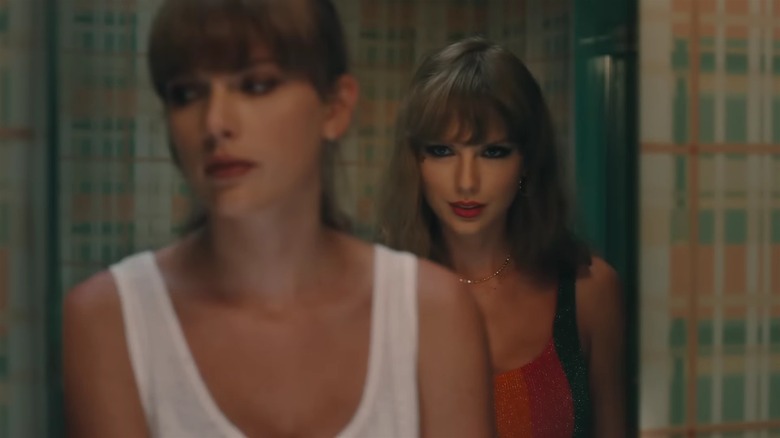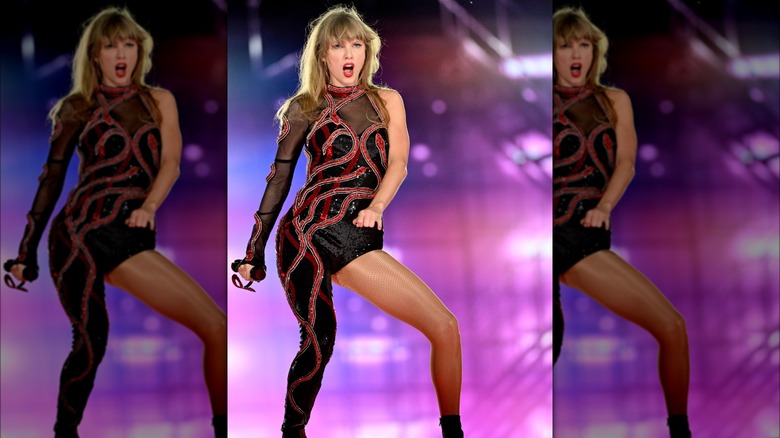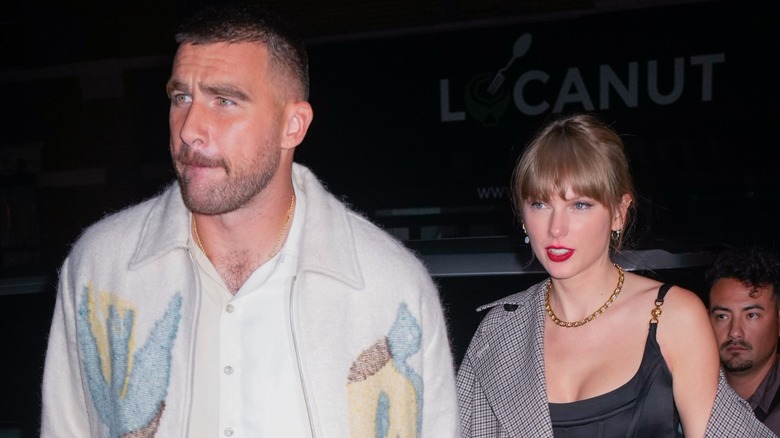Taylor Swift's Stunning Transformation
Taylor Swift once sang, "I promise that you'll never find another like me!" These days, that feels truer than ever, as the singer continues to shatter sales records and dominate the cultural conversation. Swift somehow feels more popular than ever, nearly two decades into her career. In November 2023 alone, for example, USA Today hired a reporter solely to cover Swift news, and fans even camped outside for months in Argentina to have a chance at being front-row at the Eras Tour.
That being said, Swift has certainly had her ups and downs. Sometimes she's felt "happiness," and others she's been left "lying on the cold hard ground." She's had to deal with "Mean" critics writing about her vocal talents, and there's a long-standing feud with a certain rapper that has followed her for many years, no matter how much she claimed, "I Forgot That You Existed."
The old Taylor may not be able to "come to the phone right now," but that won't stop us from taking a look through the archives and revisiting her career over the years. Whether you're a Swiftie who's been there since she was trying to find "A Place In This World," or you're a Kansas City Chiefs fan whose only familiarity is that she became a meme on Twitter for "eating a piece of chicken with ketchup and seemingly ranch," here's a look back at the stunning transformation of Taylor Swift. "Are you ready for it?"
Taylor Swift spent her childhood on a Christmas Tree Farm
"There's one thing you should know about me before we begin," Taylor Swift once said. "I was born in 1989!" It's true; the future superstar was born in the final months of the 80s to two people who worked in finance. Her parents were business-minded from the very beginning, including in the way they named their daughter. Swift told Rolling Stone that they picked her an androgynous name that would look good on a business card, explaining, "She wanted me to be a business person in a business world."
She grew up on a Christmas tree farm in Pennsylvania, and she seems to have loved it. "I had the most magical childhood, running free and going anywhere I wanted to in my head," she reminisced to Rolling Stone. Speaking with Esquire, she recalled that everyone in the family helped out. "We all had jobs," she said. "Mine was picking the praying mantis pods off of the trees, collecting them so that the bugs wouldn't hatch inside people's houses."
When she was 6, Swift discovered country music thanks to a LeeAnn Rimes album, and she fell in love with the genre. She moved on to Faith Hill, The Dixie Chicks, Shania Twain, and more, and the budding musician was hooked. "All I wanted to hear from then on was country," she said. In middle school, she began playing guitar. She told Rolling Stone, "I would literally play until my fingers bled."
She was a working musician by 13
By the time she was a teenager, Taylor Swift's family relocated to Nashville so that she could pursue a career. She landed a development deal at RCA when she was only 13, but she decided not to renew the deal after the first year, insistent on only recording music that she herself had written. "A lot of people ask me, how did you have the courage to walk up to record labels when you were 12 or 13 and jump right into the music industry?" Swift recalled in an interview with Entertainment Weekly. She answered her own question. "It's because I knew I could never feel the kind of rejection that I felt in middle school," she said.
In high school, too, Swift felt left out. She told Rolling Stone that she felt more like an "attendant" than a member of the homecoming court, ruminating, "I was the girl who didn't get invited to parties." Still, she had some friends. (Hi, Abigail!) "If I did happen to go [to parties], no one would throw a bottle at my head," she added.
She was homeschooled for her final two years of high school, because by that point, Swift had signed a new recording contract. She linked up with Big Machine Records, run by Scott Borchetta. "I base a lot of decisions on my gut," Swift told Rolling Stone, "and going with an independent label was a good one." However, she would later regret that decision.
Taylor Swift: Country Star
Taylor Swift's first two albums, "Taylor Swift" and "Fearless," were huge successes in the country music world. Singles like "Teardrops on My Guitar," "Fifteen," and "Love Story" showcased a songwriter who was able to take small moments of teenage love and turn them into gold. And the world responded accordingly; "Fearless" was the #1 album in the country for eight weeks.
During these eras, Swift often appeared with her hair in golden ringlets. The album cover for "Fearless" even made them the central focus of her image, a wild spray of hair spread out behind her. She often performed with a guitar, and her music was full of the imagery of fairy tales. While her look was usually toned down, Swift began making moves toward the "red lip, classic" look that would come to define the majority of her career. "I bought red lipstick the other day," she told The Boot in 2008. "I think people are going to throw something at me if I wore red lipstick! But ... I just looked down and saw the red lipstick and said, 'I need a change.'"
From early on, Swift had an eye on dominating the pop world, too. Still, she told Rolling Stone, her loyalty would always be to the country music scene that opened the door for her. "You can't forget who brought you to the party," she said. "And that's country radio."
Kanye West vs. Taylor Swift at the VMAs
By the time the VMAs rolled around in the fall of 2009, Taylor Swift was on the rise. Songs like "Love Story" and "You Belong With Me" had been crossover pop-country hits, and the video for the latter was nominated for Best Female Video. When she won the award, Swift took the stage to accept, but disaster struck ... a disaster by the name of Kanye West. He hopped on stage and took the microphone from Swift, delivering a rant that would live on in infamy — and approximately seventy bajillion memes. "Yo, Taylor, I'm really happy for you, I'mma let you finish," he said (via Billboard). "But Beyoncé had one of the best videos of all time!"
Producers were stunned. As director Hamish Hamilton told Billboard, "In the moment there were a lot of very different moods: terror, oh my goodness, [and] this is absolutely fantastic ... it was everything you pray for and then some." Swift, however, had to perform shortly after, still looking shaken up.
The event kicked off a feud that would continue for many years, with both stars embarking on a cycle of forgiveness and renewed anger. In 2010, Swift was asked about this moment by Allure and claimed she and West had reached a state of grace. "I've always believed in forgiveness, once someone has the courage to apologize and does so with sincerity," she said. "And [Kanye] did that."
She worked alone on Speak Now
In the wake of the Kanye West incident, Taylor Swift said, "Next chapter." For the first time, she went into the studio alone, with no other co-writers helping her craft the confessional songs that had become her trademark. "Speak Now" was the album that resulted from those sessions, and it was released in 2010. "I love this album because it tells a tale of growing up, flailing, flying and crashing ... and living to speak about it," she wrote on Twitter years later.
One of the songs on the album, "Mean," addressed critics who had begun to write negatively about Swift's musical talent. In an appearance on "The Tonight Show with Jay Leno," Swift explained, "I actually wrote the song about a critic who kept giving me really bad reviews. ... And then there's, like, the scathing review, which is kind of past constructive criticism, and it's more into like, 'I hate you' territory, which is mean!"
In other words, Swift had become so famous that her lyrics now reflected on her own fame, a thread that would continue for the rest of her career. Still, Swift took the criticism to heart and strove to improve her craft, working in particular on her singing ability. "To try and confront these demons, I underwent extensive vocal training," she later shared (via Teen Vogue). "Mean," for the record, netted her two Grammy Awards.
She began dabbling with pop on Red
By the time she released the album "Red" in 2012, Taylor Swift was a regular tabloid fixture. Her romances with fellow stars like Jake Gyllenhaal and Harry Styles were tracked closely by fans and the media. Accordingly, her songs became a sort of puzzle, as fans combed through lyrics for clues to see who the songs were about. The strategy was a winning one. The album's lead single "We Are Never Getting Back Together," for example, spent three weeks atop the Billboard Hot 100.
Musically, Swift wrote collaboratively, inviting songwriters like Ed Sheeran to help craft what were quickly becoming pop crossover songs. "If I were to think outside the box enough, go in with different people," Swift mused to Billboard, "I could learn from and have what they do rub off on me as well as have what I do rub off on them." Around this time, Swift also developed a signature look. Red heart-shaped sunglasses, a bold red lip, and block-print slogan shirts became all the rage thanks to their appearance in the music video for "22."
"Red" was a turning point for another reason, too: A brewing backlash. During this era, Tina Fey and Amy Poehler poked fun at the "I Knew You Were Trouble" singer while onstage at the Golden Globes. Quoting Katie Couric quoting Madeline Albright, Swift told Vanity Fair, "There's a special place in hell for women who don't help other women."
1989 signaled the arrival of Taylor Swift: Popstar
The 2014 album "1989" became Taylor Swift's first full-on, unapologetic, no-holds-barred pop album. Gone were the acoustic vibes of her early work, replaced by electropop bangers like "Bad Blood" that referenced things like her simmering feud with Katy Perry. She moved from Nashville to New York City, later responding to criticism of her song "Welcome To New York" in an interview with Billboard. "I'm as optimistic and enthusiastic about New York as I am about the state of the music industry, and a lot of people aren't optimistic about those two things," she said, shrugging off people who disliked the track. "And if they're not in that place in their life, they're not going to relate to what I have to say."
Swift went head to head with Spotify during this era, pulling her music from the streaming service in an effort to secure better royalties for its artists. "Music is art, and art is important and rare. Important, rare things are valuable," she wrote in an op-ed for The Wall Street Journal. "Valuable things should be paid for." The standoff would continue until 2017.
Around this time, Swift was very visibly the leader of a "Squad" of friends that included Lena Dunham, Lorde, the HAIM sisters, and more. Swift later realized she was overcompensating for not feeling accepted in school. As she told Elle, "It's important to address our long-standing issues before we turn into the living embodiment of them."
Taylor Swift's mysterious alter ego
2016 was pivotal for Taylor Swift. When she attended the Met Gala that year, she set tongues wagging with a bleach-blonde look and unexpected dark lips. She called the look "futuristic gladiator" in an interview with Vogue. Her style transformation continued that summer. Swift was dating superstar producer and DJ Calvin Harris at the time, and she showed up to Coachella with the same bleach-blonde bob. She captioned an Instagram snap (via E! Online) "Bleachella."
In the same photo, Swift sported a denim jacket bearing the single cover for Harris' song "This Is What You Came For," a Rihanna collab. The song was co-written by someone named Nils Sjöberg, who did not seem to actually exist. That summer, the song's writing credit was altered, revealing that Swift herself was Sjöberg. It would be four more years before the "Mastermind" singer discussed the pseudonym, finally coming clean in a conversation with Paul McCartney for Rolling Stone. "You don't want the work to become overshadowed by this thing that's been built around you, based on what people know about you," she mused. "And that's when it's really fun to create fake names and write under them."
In other words, Swift was beginning to chafe at the edges of the "Taylor Swift" persona, wondering whether the expectations people had of her career were sustainable. She would soon find out that, perhaps, they were not.
Taylor Swift's Reputation had never been worse
In early 2016, Kanye West released a song called "Famous," rapping, "I think me and Taylor might still have sex / Why, I made that b**** famous." West claimed that Swift had given him permission, while Swift insisted she had not. "[She] cautioned him about releasing a song with such a strong misogynistic message," a representative told People. That July, West's then-wife Kim Kardashian released "receipts" on her Snapchat, posting several videos of a phone conversation between West and Swift. Swift appears to give West the go-ahead, though upon closer inspection, it becomes clear that he never actually tells her about calling her a derogatory name. In a since-deleted Instagram post about the situation, Swift pointed this out and wrote, "I would very much like to be excluded from this narrative, one that I have never asked to be a part of, since 2009."
After a period of relative silence, Swift came back with 2017's "Reputation," an album that leaned into the backlash. "My reputation's never been worse," she sang on "Delicate." The lead single "Look What You Made Me Do" was filled with snake imagery and references to past iconic looks, even poking fun at her own "excluded from this narrative" quote.
She barely spoke with the press during this era, later explaining that decision to The Guardian. "Every domino fell ... I felt completely incapable of doing or saying anything publicly, at all. Even about my music."
In the Lover era, Taylor Swift got political
Up until this point in her career, Taylor Swift was many things, but "political" wasn't one of them. Her refusal to endorse a candidate during the 2016 presidential election, among other things, led to parts of the internet calling her a white supremacist. In 2019, embarking on a promotional cycle for her album "Lover," Swift finally disavowed any connection to the alt-right. "There's literally nothing worse than white supremacy. It's repulsive," she told Rolling Stone. "There should be no place for it."
She began engaging regularly in politics, a risky business decision chronicled in her "Miss Americana" documentary, released in 2020. "I need to be on the right side of history," she told a disapproving business team that included her father (via Variety). "Dad, I need you to forgive me for doing it, because I'm doing it."
This new, politically-active incarnation of Swift included speaking out for gay rights, something she supplemented by including a number of queer celebrities in the music video for "You Need To Calm Down." Stars like Jesse Tyler Ferguson, Todrick Hall, Jonathan Van Ness, and more supported Swift as she sang lines like, "Shade never made anybody less gay." She also dressed as a man in the self-directed music video for "The Man," a song asking how her music would be received if she were a man. "The more we talk about [gender inequality]," she told Billboard, "the better off we'll be."
Folklore and Evermore changed the narrative
If the COVID-19 pandemic hadn't happened, Taylor Swift would have embarked on a series of "Lover Fest" shows in support of her album "Lover." After initially delaying the shows indefinitely, Swift finally announced in February 2021 that the tour dates were officially canceled. "I miss you terribly and can't wait til we can all safely be at shows together again," she wrote on Twitter.
While we'll never know what Lover Fest might have been like, Swift had already moved on anyway. In July 2020, she surprise-dropped "folklore," an album that stripped her music back to its singer-songwriter roots. The album also represented a new transformation for Swift, because, in addition to mining her own life for inspiration, she decided to explore other points of view. "I found myself not only writing my own stories, but also writing about or from the perspective of people I've never met, people I've known, or those I wish I hadn't," she explained (via NME). "In isolation my imagination has run wild and this album is the result."
A few months later, she did it again: The "folklore" follow-up "evermore" was released that December. She told Zane Lowe (via Variety), "There was a point that I got to as a writer who only wrote very diaristic songs that I felt it was unsustainable for my future moving forward." She explained the change, saying, "My world felt opened up creatively."
The re-records, Midnights, and breaking up with Joe Alwyn
In 2019, Taylor Swift went public with her frustration over the rights to her masters. Big Machine Records, her first label, had been sold to Scooter Braun. "My musical legacy is about to lie in the hands of someone who tried to dismantle it," Swift wrote on Tumblr, detailing all of the ways Braun had been involved in attempts to undercut her career. She announced on "Good Morning America" that she would be re-recording her early albums, releasing new versions for fans to stream so that royalties would no longer go to Braun.
The projects began rolling out during the COVID-19 pandemic, propelling Swift's career to new heights. When "Red (Taylor's Version)" was released in 2021, "All Too Well (10 Minute Version)(Taylor's Version)(From the Vault)" and its corresponding short film made quite the splash. Swift directed it herself, telling the Tribeca Film Festival (via Page Six), "I'm really secret agent-y about people not finding out about what we're making ... Everything was codewords. ... I'm so weird with stuff like that."
On her 2022 album "Midnights," Swift admitted she's a "Mastermind." Being a Swiftie had always involved some amount of interpretation and clue-finding, but with a fandom now supercharged by TikTok, Swift promoted this album with a barrage of easter eggs. Shortly after the album's release, she broke up with longtime boyfriend Joe Alwyn, kicking off a new era we hadn't seen in six years: A single Swift.
Taylor Swift's record-breaking Eras Tour
Following the Reputation World Tour, Taylor Swift released a staggering six albums before she performed live for fans again. In spring 2023, she embarked on The Eras Tour, which she referred to on Instagram as "a journey through the musical eras of my career (past and present!)." The tour proved to be an impressive feat of endurance, with Swift cycling through more than 40 songs over a concert runtime that passed three hours.
The tour was a massive success, dominating social media chatter and sparking a craze where fans gave each other friendship bracelets at the show. "I've just never been this happy in my life in all aspects of my life ever," Swift said during one stop, according to USA Today. "It's not just a tour. I just sort of feel like my life finally feels like it makes sense." In some senses, her reputation had never been better.
In October 2023, Swift released a film version of the tour. It quickly shattered records, becoming the highest-grossing concert film of all time in its first three days. At the film's Los Angeles premiere, Swift reiterated what a blast she was having in this new "Eras" era. "I've never had a fraction of the amount of fun I had on the Eras Tour before, ever," she said. Fans, it seems, agreed.
Taylor Swift, football girlfriend?
Taylor Swift's latest romance — with Kansas City Chiefs tight end Jason Kelce — has caused a media firestorm. Sparks began to fly in September 2023, when Kelce confirmed on an episode of "The Pat McAfee Show" that he'd expressed interest in the "Shake It Off" singer. "I've seen you rock the stage at Arrowhead [Stadium]," he recalled telling Swift. "You might have to come see me rock the stage at Arrowhead and see which one's a little more lit."
Swift did exactly that several days later. Fans (and the media) spotted her hanging out in Kelce's box during a Chiefs game, watching the game with his mom. "She just thought it was a fantastic way to spend Sunday," a source told People. Things progressed quickly from there, with both stars showing up on "Saturday Night Live" in early October. Even though "no one knew they were coming," as a source told Variety, they each made on-camera appearances. In other words, their love connection was as good as confirmed.
In addition to hanging out with the football player himself, Swift has also gotten to know other women in relationships with players. In particular, she has grown close with Brittany Mahomes, wife of Kelce's teammate Patrick Mahomes. They stepped out in New York alongside Sophie Turner, Selena Gomez, Gigi Hadid, and Cara Delevingne, suggesting that perhaps, in Swift's new era, The Squad has returned.
